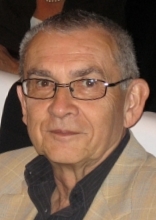Yuri Manin
Yuri Manin | |
|---|---|
Юрий Манин | |
 Manin in 2006 | |
| Born | Yuri Ivanovich Manin 16 February 1937 Simferopol, Crimean ASSR, Russian SFSR, Soviet Union |
| Died | 7 January 2023 (aged 85) |
| Nationality | Russian |
| Alma mater |
|
| Known for | Manin conjecture Manin matrix Manin obstruction Manin triple Manin–Drinfeld theorem Manin–Mumford conjecture ADHM construction Gauss–Manin connection Cartier–Manin operator CH-quasigroup Modular symbol Quantum simulator |
| Awards |
|
| Scientific career | |
| Fields | Mathematics |
| Institutions |
|
| Doctoral advisor | Igor Shafarevich |
| Doctoral students | |
Yuri Ivanovich Manin (Russian: Ю́рий Ива́нович Ма́нин; 16 February 1937 – 7 January 2023) was a Russian mathematician, known for work in algebraic geometry and diophantine geometry, and many expository works ranging from mathematical logic to theoretical physics.
Life and career
Manin was born on 16 February 1937 in Simferopol, Crimean ASSR, Soviet Union.[2]
He received a doctorate in 1960 at the
He had over the years more than 40 doctoral students, including Vladimir Berkovich, Mariusz Wodzicki, Alexander Beilinson, Ivan Cherednik, Alexei Skorobogatov, Vladimir Drinfeld, Mikhail Kapranov, Vyacheslav Shokurov, Ralph Kaufmann, Arend Bayer, Victor Kolyvagin and Hà Huy Khoái.[5]
Manin died on 7 January 2023.[2]
Research
Manin's early work included papers on the arithmetic and
He developed the
Manin pioneered the field of arithmetic topology (along with John Tate, David Mumford, Michael Artin, and Barry Mazur).[10] He also formulated the Manin conjecture, which predicts the asymptotic behaviour of the number of rational points of bounded height on algebraic varieties.[11]
In mathematical physics, Manin wrote on
He wrote a book on
Awards
He was awarded the
In 1990, he became a foreign member of the Royal Netherlands Academy of Arts and Sciences.[16] He was a member of eight other academies of science and was also an honorary member of the London Mathematical Society.[2]
Selected works
- Mathematics as metaphor – selected essays. American Mathematical Society. 2009.
- "Rational points of algebraic curves over function fields". AMS translations 1966 (Mordell conjecture for function fields).
- Manin, Yu I. (1965). "Algebraic topology of algebraic varieties". Russian Mathematical Surveys. 20 (6): 183–192. S2CID 250895773.
- Frobenius manifolds, quantum cohomology, and moduli spaces. American Mathematical Society. 1999.[17]
- Quantum groups and non commutative geometry. Montreal: Centre de Recherches Mathématiques. 1988.
- Topics in non-commutative geometry. Princeton University Press. 1991. ISBN 9780691635781.[18]
- Gauge field theory and complex geometry. Grundlehren der mathematischen Wissenschaften. Springer. 1988.[19]
- Cubic forms - algebra, geometry, arithmetics. North Holland. 1986.
- A course in mathematical logic. Springer. 1977.,[20] second expanded edition with new chapters by the author and Boris Zilber, Springer 2010.
- Computable and Uncomputable. Moscow. 1980.
{{cite book}}: CS1 maint: location missing publisher (link)[14] - Mathematics and physics. Birkhäuser. 1981.
- Manin, Yu. I. (1984). "New dimensions in geometry". Arbeitstagung. Lectures Notes in Mathematics. Vol. 1111. Bonn: Springer. pp. 59–101. ISBN 978-3-540-15195-1.
- Manin, Yuri; S2CID 124713118.
- Manin, Yuri; Gelfand, Sergei (1994). Homological algebra. Encyclopedia of Mathematical Sciences. Springer.
- Manin, Yuri; Gelfand, Sergei Gelfand (1996). Methods of Homological algebra. Springer Monographs in Mathematics. Springer. ISBN 978-3-642-07813-2.
- Manin, Yuri; Kobzarev, Igor (1989). Elementary Particles: mathematics, physics and philosophy. Dordrecht: Kluwer.
- Manin, Yuri; Panchishkin, Alexei A. (1995). Introduction to Number theory. Springer.
- Manin, Yuri I. (2001). "Moduli, Motives, Mirrors". European Congress of Mathematics. Progress in Mathematics. Barcelona. pp. 53–73. ISBN 978-3-0348-9497-5.)
{{cite book}}: CS1 maint: location missing publisher (link - Classical computing, quantum computing and Shor´s factoring algorithm (PDF). Bourbaki Seminar. 1999.
{{cite book}}: CS1 maint: location missing publisher (link) - Rademacher, Hans; Toeplitz, Otto (2002). Von Zahlen und Figuren [From Numbers and Figures] (in German). ISBN 978-3-662-35411-7.
- Manin, Yuri; S2CID 25731842.
- Manin, Yu. I. (December 1991). "Three-dimensional hyperbolic geometry as ∞-adic Arakelov geometry". Inventiones Mathematicae. 104 (1): 223–243. S2CID 121350567.
- Mathematik, Kunst und Zivilisation [Mathematics, Art and Civilisation]. Die weltweit besten mathematischen Artikel im 21. Jahrhundert. Vol. 3. e-enterprise. 2014. ISBN 978-3-945059-15-9.
See also
References
- doi:10.1090/noti2814.
- ^ a b c d e "Max Planck Institute for Mathematics in Bonn Mourns Death of Yuri Manin". Max Planck Institute for Mathematics. 8 January 2023. Retrieved 8 January 2023.
- ^ "Yuri Manin | Max Planck Institute for Mathematics". www.mpim-bonn.mpg.de. Retrieved 6 August 2018.
- ^ "Emeriti Faculty: Department of Mathematics – Northwestern University". math.northwestern.edu. Retrieved 6 August 2018.
- ^ Yuri Manin at the Mathematics Genealogy Project
- MR 0103889
- ^ "Gauss-Manin connection", Encyclopedia of Mathematics, EMS Press, 2001 [1994]
- Zbl 0869.11051.
- Zbl 0951.14013.
- ISBN 978-1-4471-2157-2.
- ^
Franke, J.; Zbl 0674.14012.
- .
- ^ Devchand, Chandrashekar; Ogievetsky, Victor I. (1996). "Integrability of N=3 super Yang-Mills equations". Topics in statistical and theoretical physics. Amer. Math. Soc. Transl. Ser. 2. Vol. 177. Providence, RI: American Mathematical Society. pp. 51–58.
- ^ a b Manin, Yu. I. (1980). Vychislimoe i nevychislimoe [Computable and Noncomputable] (in Russian). Sov.Radio. pp. 13–15. Archived from the original on 10 May 2013. Retrieved 4 March 2013.
- ^ Manin: Cubic forms – algebra, geometry, arithmetics, North Holland 1986
- ^ "Y.I. Manin". Royal Netherlands Academy of Arts and Sciences. Retrieved 19 July 2015.
- .
- .
- .
- .
Further reading
- Némethi, A. (April 2011). "Yuri Ivanovich Manin" (PDF). .
- Jean-Paul Pier (1 January 2000). Development of Mathematics 1950–2000. Springer Science & Business Media. p. 1116. ISBN 978-3-7643-6280-5.
External links
- Manin's page at Max-Planck-Institut für Mathematik website
- Good Proofs are Proofs that Make us Wiser, interview by Martin Aigner and Vasco A. Schmidt
- Biography
- Interviewed by David Eisenbud for Simons Foundation "Science Lives"
- Fedor Bogomolov; Yuri Tschinkel, eds. (December 2023). "Memorial Article for Yuri Manin" (PDF). Notices of the American Mathematical Society. 70 (11): 1831–1849. doi:10.1090/noti2814.
